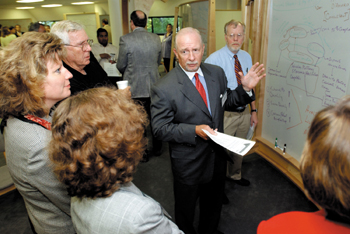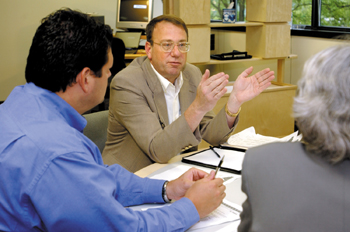
Dr. Harry R. Jacobson participated in a brainstorming session to identify goals and strategies for transforming health care with information technology. (photo by Anne Rayner Pollo)
New Vanderbilt center formed
to transform health care delivery

Dr. William Stead leads a discussion of the impact biomedical informatics will have on the advancement of health care in the future. (photo by Anne Rayner Pollo)
Throughout much of our economy, information technology has long since transformed the manufacture and delivery of goods and services, but its use to support the delivery of care in hospitals and clinics is seen to have lagged. Reasons for the delay range from the unique culture and complexity of medicine to the apparent lack of clear financial incentives for providers to develop and fund the necessary changes.
Meanwhile, urgency has been mounting around issues of health care quality, safety and cost. Estimates of waste in the nation’s health care system (a $1.2 trillion industry) run into the hundreds of billions of dollars. According to a 2000 report from the Institute of Medicine (an arm of the National Academy of Sciences), annual deaths due to medical error number between 44,000 and 98,000. Last year’s Institute of Medicine report, “Crossing the Quality Chasm: A New Health System for the 21st Century,” called for fundamental change in the way health care is organized and the environment in which care is delivered.
Vanderbilt, having over the past decade become one of the world’s leading centers for biomedical informatics, is moving to help span the gap separating information technology from patient care delivery. After 18 months of study and careful formulation, Vanderbilt leaders Dr. Harry R. Jacobson and Dr. William W. Stead have unleashed a strategy that uses Vanderbilt’s expertise in education, health care and biomedical informatics to bring about the transformation of health care delivery through expanded use of information technology.
This huge endeavor is the mission of the new Vanderbilt Center for Better Health, which will reach out to the nation’s health care system from its new high-tech Innovation Center housed near campus in the office building at 3401 West End Ave.
“The purpose of the center is to discover how to maximize the benefits of information technology for health care and health care delivery,” said Jacobson, vice chancellor for Health Affairs.
As conceived by Jacobson and Stead, the center will work to define a national agenda and build momentum for transformation, conduct research, partner with organizations for rapid design and deployment of new technology, and develop and disperse information, tools and services to stimulate change. The center will work with providers, suppliers and other industry players, with this change activity expected ultimately to impact policy and the public debate on health care.
The center will draw expertise from various parts of Vanderbilt, including the Schools of Medicine and Nursing, Peabody College, Owen Graduate School of Management and the School of Engineering. Stead, associate vice chancellor for Health Affairs and chief information architect for Vanderbilt, is chairman of the new center.
“What we are attempting to do is to create a critical mass to help the health care system through the changes that need to take place to achieve the benefits that are possible through informatics,” Stead said. “It’s my belief that if we give patients the tools to participate in decision making and to track their own progress, and if we give physicians and other care providers the tools to do the right thing and only the right thing, we can probably take out up to 40 percent of the work that is currently being done in the health system while fundamentally improving outcomes.”
The center’s inaugural event was a June 6-7 national conference on computerized physician order entry, which drew some 60 participants, including leaders from academic centers, national provider networks, quality advocacy groups and the information technology industry. Participants at the conference began to craft strategies to overcome barriers to the use of information technology to deliver better health care.
“You can’t simply throw computer systems at the problem,” said David Osborn, executive director of the center. “The change involves the intersection of people, care processes and technology, and all three of these elements are required to get transformational results.”
“What we’ve learned is that putting new infrastructure with old ways of working doesn’t work,” Stead said. “What’s needed is discontinuous change leading to new ways of working.”
As a member of the Institute of Medicine, Stead helped review the “Quality Chasm” report. “The challenge that the report puts in front of us, or the thing it leaves undone,” Stead said, “is that it assumes that the information technology infrastructure will be there and that people will naturally work with that infrastructure. We have just as much work to do in figuring out what the right infrastructure is and what the right ways of working with it are as we have in the health care aspects that this report concentrated on.”
Stead defines biomedical informatics as, “A new science that deals with how you structure information so that very simple systems make complex relationships clear.”
Over the past decade at Vanderbilt, Stead and Dr. Randolph A. Miller, chair of the department of Biomedical Informatics, have assembled one of the world’s leading biomedical informatics faculties, and Vanderbilt’s ongoing efforts to develop and deploy information technology could provide an example to other centers.
Modus operandi
“Before WizOrder was developed,” Jacobson said, “someone asked the question, ‘Would it be useful to give doctors information at their fingertips as they write orders?’”
The center will first of all provide neutral ground where parties can come together to agree on the agenda for change, including the question of what research might prove most instrumental for change. The center will pursue the research agenda both on its own and in partnership with other groups. Using a test bed strategy, the center will work directly with different providers for rapid design and deployment of information technology solutions. In addition, the center will assemble methods, tools and consulting services to assist transfer of knowledge to the health care system at large.
The center has identified several areas for research, ranging from knowledge management, consumer informatics, and organizational design to cognitive learning, management and law. It’s expected the center will have five endowed faculty chairs at Vanderbilt within five years, with a later goal of six additional endowed chairs.
The Innovation Center at 3401 West End provides a highly flexible and re-configurable work environment for intense two- to three-day design sessions, learning and knowledge transfer events, and other collaborative work meetings involving representatives of VUMC and other health care organizations. Equipped with state-of-the-art technology and audio-visual capability, the Innovation Center will also support the work of research and project teams comprised of VUMC staff and members of other organizations working together to design, develop, test and implement tools and solutions focused on transforming how health care is delivered.
At the recent conference on CPOE, the center distributed the first of its tools, a multimedia program on compact disc, produced in partnership with Dr. John Bransford’s team at the Learning Science Institute at Peabody College, designed to assist adoption of information technology by physicians. Participants at the conference also heard about a data base tool, still under development in partnership with Dr. David Dilts of the Owen Graduate School of Management, that organizations will use both to help predict return on investment from CPOE and to guide planning and implementation.
To safeguard its credibility, the center will maintain strict neutrality regarding specific applications and specific health care technology vendors. (Last year Vanderbilt licensed rights for commercial development and marketing of WizOrder, and VUMC is preparing to develop additional applications for commercial release.)
With Stead providing the vision and managing the intersection of Vanderbilt’s various schools with the center, Osborn is responsible for carrying out the vision, including developing and achieving the business plan. Osborn has 20 years of experience in technology consulting to health care organizations, most recently as a partner with KPMG Consulting. Including Osborn, the center has a start-up group of four staff members. They’ve started with a significant investment from Vanderbilt, and they’re currently visiting foundations and corporations to seek out sponsors and partners, with the goal of raising a sizeable endowment. For more information, visit the center’s Web site, http://www.mc.vanderbilt.edu/vcbh.













